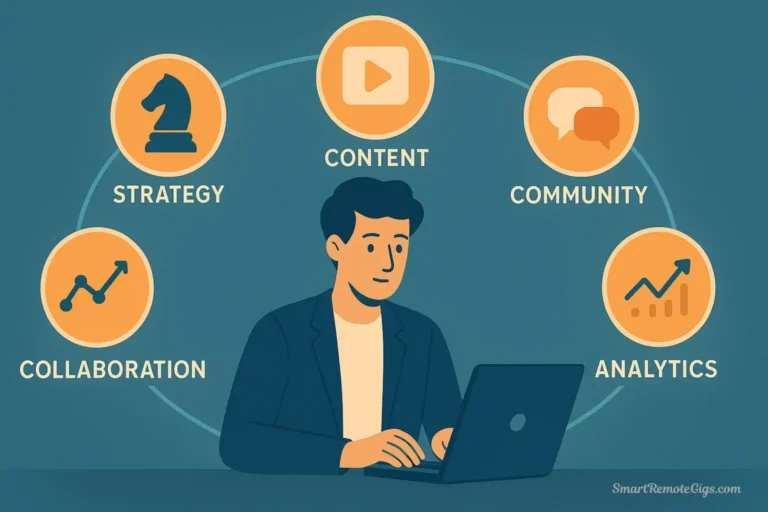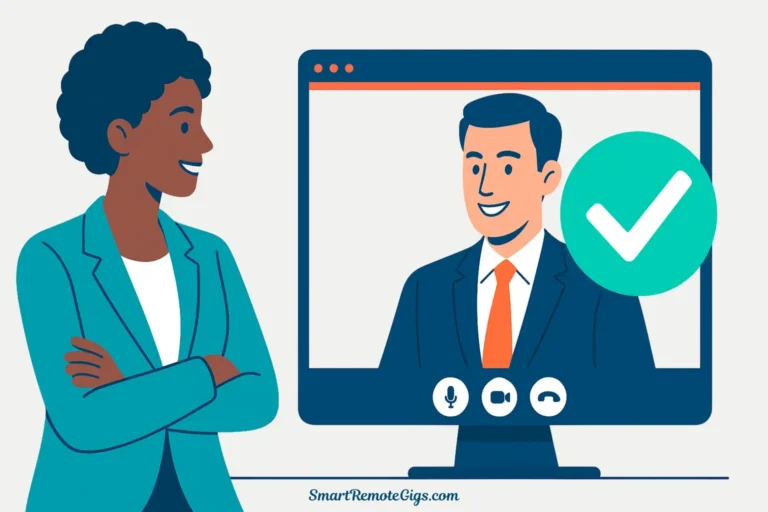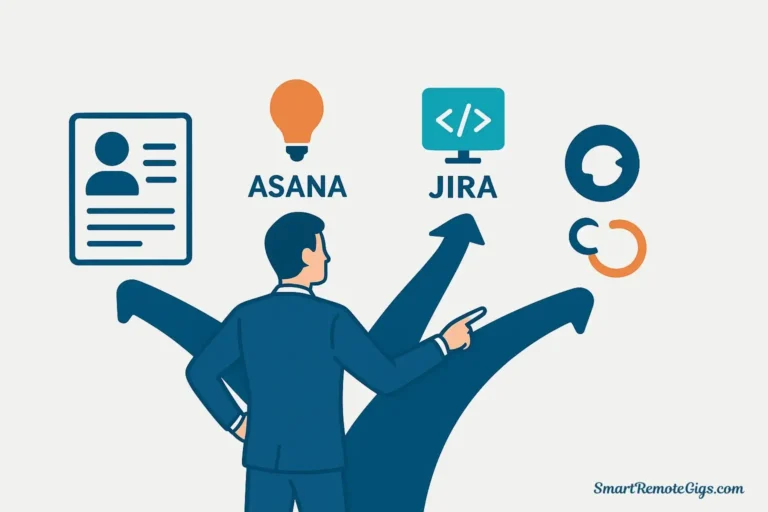The remote tier 1 tech support field offers one of the clearest pathways into a lucrative technology career without requiring a computer science degree or years of coding experience. While many view these positions as temporary stepping stones, smart professionals recognize them as strategic launchpads that provide paid training, industry exposure, and direct pathways to specialized IT roles earning $60,000-$100,000+ annually.
This comprehensive guide reveals how to leverage your existing customer service skills, master the behavioral interview process, and systematically advance through the IT career ladder. Unlike generic job advice, we’ll focus on the specific strategies that transform entry level help desk jobs into launching pads for network administration, cybersecurity, and systems engineering careers.
The remote work revolution has dramatically expanded opportunities in IT support for beginners, with major corporations now hiring thousands of remote support professionals annually. Companies like Apple, Dell, and Amazon regularly recruit entry-level candidates who demonstrate strong problem-solving abilities and customer communication skills, regardless of formal technical education.
💡 New to remote work entirely? Check out our comprehensive Remote Jobs No Experience: Your Definitive 2025 Guide for strategies that apply across all industries, then return here for tech-specific tactics.
Why Tier 1 Support is Your Launchpad into a Tech Career
If you’re looking for more than just a job, a Tier 1 Tech Support role is one of the smartest moves you can make. This guide is designed for people without a tech degree. We’ll show you how to leverage your customer service skills to get hired and map out your career path for years to come.
The Hidden Value of Tier 1 Positions
While tier 1 support interview questions focus heavily on customer service scenarios, the real value lies in the comprehensive technical training you receive while getting paid. Major companies invest $5,000-$15,000 in training each new hire, covering everything from network troubleshooting to software deployment—education that would cost tens of thousands at traditional institutions.
Tier 1 support professionals gain exposure to:
- Enterprise-level software and hardware systems
- Network architecture and security protocols
- Database management and user administration
- Project management and change control processes
- Industry-standard ticketing and monitoring tools
The Financial Trajectory
Unlike retail or food service positions, tech support offers clear advancement metrics and predictable salary progression:
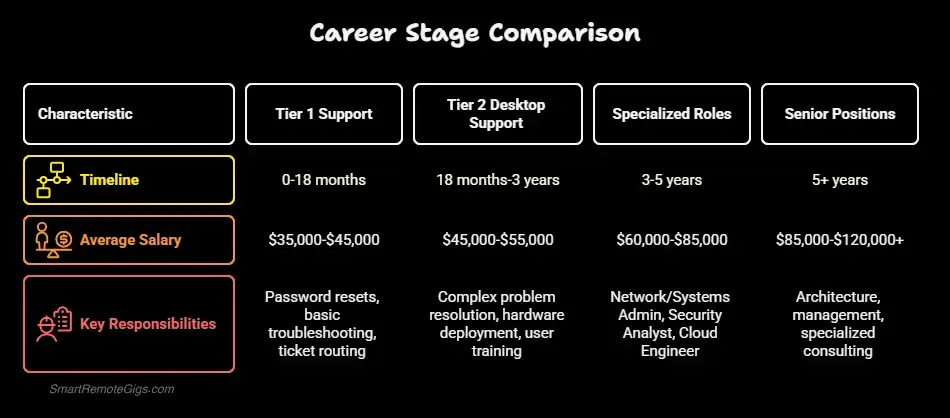
Why Companies Hire from Within
Technology companies strongly prefer promoting internal candidates for several strategic reasons. Internal hires already understand company systems, policies, and culture, reducing onboarding time and risk. They’ve demonstrated reliability and problem-solving abilities under pressure, qualities difficult to assess from external interviews alone.
This internal hiring preference creates a significant advantage for Tier 1 professionals who approach their roles strategically, viewing each day as paid training for their next career level.
The Soft Skills That Matter More Than Technical Knowledge

IT support for beginners success depends far more on interpersonal abilities and systematic thinking than technical knowledge. While companies provide comprehensive technical training, they cannot easily teach the soft skills that separate exceptional support professionals from adequate ones.
Empathy & Patience: The #1 Requirement
Why Emotional Intelligence Dominates Technical Skills
Tech support interactions occur during users’ most frustrating moments—when technology fails and productivity stops. Your ability to remain calm, acknowledge their frustration, and guide them toward solutions determines both customer satisfaction and your career advancement potential.
The Empathy Framework for Support Calls:
- Acknowledge: “I understand how frustrating this must be when you’re trying to meet a deadline.”
- Assure: “I’m going to work with you until we get this resolved completely.”
- Act: Take concrete steps while explaining your reasoning clearly
- Follow-up: Confirm the solution works and document thoroughly
Practical Application: When a user calls about a crashed computer, your response isn’t just about technical troubleshooting—it’s about understanding the business impact, providing realistic timelines, and offering workarounds that minimize disruption to their work.
The Art of Triage: How to Ask the Right Questions
Diagnostic Questioning Separates Professionals from Order-Takers
Effective support professionals quickly identify root causes through systematic questioning rather than applying random solutions. This diagnostic approach impresses both customers and management while building the analytical skills essential for career advancement.
The Support Triage Method:
- Immediate Impact Assessment: “Is this preventing you from working right now?”
- Scope Identification: “Are other people experiencing this same issue?”
- Timeline Establishment: “When did this problem first start occurring?”
- Pattern Recognition: “What were you doing just before this happened?”
- Environmental Context: “Have there been any recent changes to your system?”
Advanced Questioning Techniques:
- Reproduce the Issue: “Can you walk me through exactly what happens when you try that?”
- Isolate Variables: “Does this happen with other applications or just this one?”
- Establish Baselines: “When was the last time this worked correctly?”
These systematic approaches demonstrate professional competence while gathering information needed for accurate problem resolution.
Clear Communication: Explaining Technical Concepts to Non-Technical People
Translation Skills Drive Career Advancement
Your ability to explain complex technical concepts in simple terms directly correlates with promotion potential. Senior IT roles require constant communication with executives, project managers, and end users who need to understand technical decisions without technical backgrounds.
The Translation Framework:
- Use Analogies: Compare network issues to traffic congestion, security to building locks
- Avoid Jargon: Replace “DNS resolution failure” with “address lookup problem”
- Provide Context: Explain why the solution matters to their specific work
- Confirm Understanding: Ask them to repeat back the key points in their own words
Example Translation:
- Technical: “The DHCP server is down, causing IP address conflicts”
- User-Friendly: “The system that assigns computer addresses isn’t working, so computers can’t find each other on the network. I’m going to assign your computer a specific address so you can get back online while we fix the main system.”
Acing the Tech Support Interview: The STAR Method
Tier 1 support interview questions focus heavily on behavioral scenarios because technical skills can be taught, but communication abilities and problem-solving approaches are harder to develop. Mastering the STAR method provides a structured framework for showcasing your potential regardless of previous tech experience.
📝 Resume Ready? Before your interview, ensure your application materials are optimized with our guide: How to Write a Remote Resume with No Experience (Examples). A strong resume gets you the interview, but interview skills get you the job.
Understanding the STAR Method
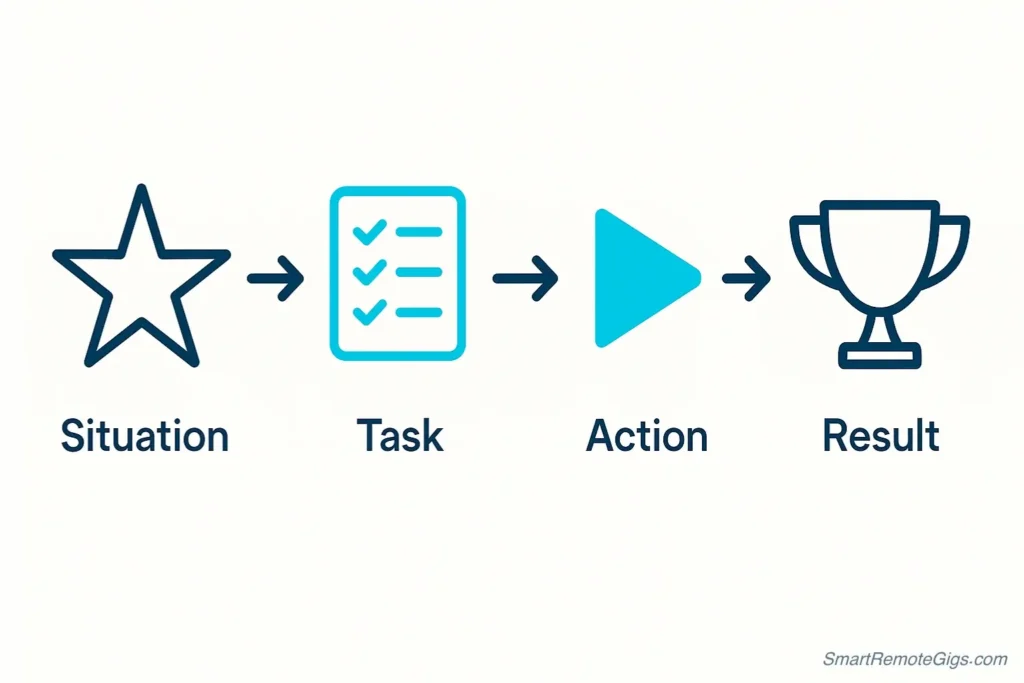
STAR Framework Breakdown:
- Situation: Set the context with specific details about the challenge
- Task: Explain your responsibility in that situation
- Action: Describe the specific steps you took to address the issue
- Result: Share the measurable outcome and lessons learned
Why STAR Works for Tech Support Interviews: The method demonstrates your ability to think systematically under pressure, communicate clearly about complex situations, and learn from experience—exactly the qualities hiring managers seek in support professionals.
5 Common Interview Questions & How to Answer Them
Question 1: “Tell me about a time you dealt with a frustrated customer.”
Sample STAR Answer:
- Situation: “In my retail job, a customer’s wedding dress order was delayed two days before her wedding due to a shipping error.”
- Task: “I needed to find a solution that would get her the dress while maintaining our company’s reputation.”
- Action: “I immediately called three other store locations, found the dress in her size, arranged for same-day delivery, and personally followed up to ensure it arrived on time. I also applied a 20% discount for the inconvenience.”
- Result: “She received the dress the next morning, and she later referred two friends to our store. I learned that taking ownership of problems, even when they’re not your fault, builds customer loyalty.”
Question 2: “How do you handle a problem you don’t know the answer to?”
Sample STAR Answer:
- Situation: “A customer at my previous job asked about a warranty policy I wasn’t familiar with for a product we rarely sold.”
- Task: “I needed to provide accurate information without appearing incompetent or making the customer wait excessively.”
- Action: “I told the customer honestly that I wanted to get them the most accurate information, placed them on a brief hold, consulted our policy manual and a senior colleague, and returned with the complete answer plus additional options they hadn’t considered.”
- Result: “The customer appreciated my thoroughness and purchased an extended warranty. My manager commended me for seeking help appropriately. I learned that customers respect honesty more than fake expertise.”
Question 3: “Describe a time when you had to explain something complex to someone.”
Sample STAR Answer:
- Situation: “My elderly neighbor asked me to help her understand why her computer was running slowly after she mentioned it was taking forever to start up.”
- Task: “I needed to diagnose the issue and explain it in terms she could understand and remember.”
- Action: “I discovered she had accumulated many startup programs. I used the analogy of having too many people trying to get through a door at once, showed her how to disable unnecessary programs, and created a simple written guide she could reference later.”
- Result: “Her computer performance improved dramatically, and she felt confident managing it herself. She still uses my guide two years later. This taught me the importance of providing solutions people can understand and maintain.”
Question 4: “Tell me about a time you made a mistake and how you handled it.”
Sample STAR Answer:
- Situation: “I accidentally scheduled two important meetings for the same time slot for my manager.”
- Task: “I needed to resolve the conflict while minimizing disruption to both parties.”
- Action: “I immediately contacted my manager to explain the error, researched alternative meeting times that worked for all parties, rescheduled both meetings with apologies and explanations, and implemented a color-coding system to prevent future scheduling conflicts.”
- Result: “Both meetings proceeded without issues, and my manager appreciated my proactive solution. The new scheduling system prevented similar errors for the entire team. I learned that addressing mistakes quickly and systematically builds rather than damages trust.”
Question 5: “How do you prioritize tasks when everything seems urgent?”
Sample STAR Answer:
- Situation: “During a busy retail shift, I had to handle customer checkouts, restock inventory, and address a pricing error that was causing customer complaints.”
- Task: “I needed to manage multiple urgent tasks while maintaining customer service quality.”
- Action: “I assessed which issues affected the most people and addressed them first: fixed the pricing error to prevent new complaints, called for backup to handle checkouts, then tackled restocking during quieter moments. I communicated wait times clearly to customers throughout.”
- Result: “Customer satisfaction remained high despite the chaos, and we resolved all issues by closing time. My manager noted my ability to stay organized under pressure. I learned that clear prioritization and communication help everyone work more effectively.”
💡 The STAR Method Success Formula
Always include specific numbers, timeframes, and measurable outcomes in your Result section. Instead of “the customer was happy,” say “the customer rated their experience 5/5 and referred two new clients.” Quantifiable results demonstrate your understanding of business impact.
🎥 Video Interview Coming Up? Most remote tech support interviews happen via video call. Master the technical and interpersonal aspects with our comprehensive guide: How to Ace a Zoom Interview: Tips for Remote Job Seekers.
The IT Career Ladder: From Tier 1 to Your Dream Job
Understanding the tech support career path transforms your approach to entry-level positions. Rather than viewing Tier 1 support as a temporary necessity, successful professionals treat it as the foundation of a systematic career development strategy.
The Strategic Career Progression
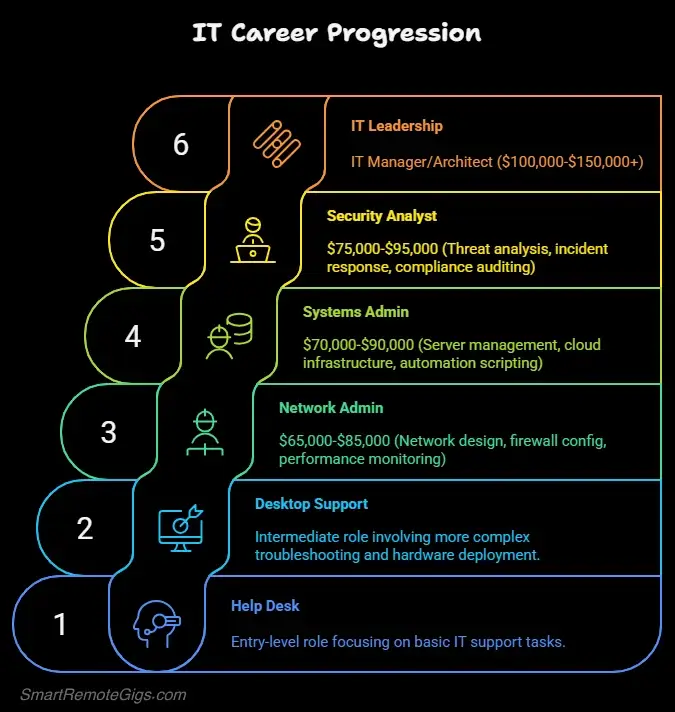
Step 1: Tier 1 Help Desk (6-18 months) → Get CompTIA A+ Certification
Primary Responsibilities:
- Password resets and account unlocks
- Basic software troubleshooting and installations
- Hardware replacement and configuration
- Ticket documentation and routing
- Customer service and communication
Key Skills Developed:
- Active Directory administration
- Windows and Mac OS troubleshooting
- Network connectivity diagnosis
- Help desk software proficiency
- Customer communication under pressure
CompTIA A+ Certification Strategy: The CompTIA A+ certification validates your technical foundation and significantly improves advancement opportunities. Most employers provide study materials and exam reimbursement, making this certification accessible while working.
Study Approach:
- Use company training resources and practice labs
- Schedule study time during slow periods at work
- Join online study groups with other IT professionals
- Take practice exams until consistently scoring 85%+
- Schedule the exam during your second year to demonstrate commitment
Step 2: Tier 2 Desktop Support (18 months – 3 years) → Get CompTIA Network+ Certification
Advanced Responsibilities:
- Complex hardware and software troubleshooting
- System imaging and deployment
- User training and documentation creation
- Basic server administration tasks
- Project support and implementation
Specialized Skills Gained:
- Group Policy management
- Mobile device management (MDM)
- Software deployment automation
- Basic scripting and automation
- Vendor management and procurement
Network+ Certification Value: CompTIA Network+ certification opens doors to specialized networking roles and demonstrates your commitment to technical growth. This certification is particularly valuable for transitioning into network administration or cybersecurity roles.
Step 3: Specialization Paths (3-5+ years)
Network Administration Path:
- Design and implement network infrastructure
- Manage firewalls, switches, and routers
- Monitor network performance and security
- Plan and execute network upgrades
- Troubleshoot complex connectivity issues
Systems Administration Path:
- Manage server infrastructure and virtualization
- Implement backup and disaster recovery solutions
- Automate routine tasks through scripting
- Manage cloud infrastructure and hybrid environments
- Ensure system security and compliance
Cybersecurity Analyst Path:
- Monitor security events and incident response
- Conduct vulnerability assessments and penetration testing
- Develop security policies and procedures
- Manage security tools and technologies
- Investigate security breaches and forensics
🎯 Career Acceleration Tip
Volunteer for special projects during your Tier 1 role. Whether it’s helping with software rollouts, documenting procedures, or training new hires, these opportunities showcase your potential and provide experience beyond standard job duties.
Where to Find the Best Entry-Level Tech Support Jobs
Remote tier 1 tech support opportunities are abundant, but knowing where to look and how to approach each source maximizes your chances of landing quality positions with growth potential.
Major Business Process Outsourcing (BPO) Companies
Sykes (Now Sitel Group)
- Specialization: Multi-industry tech support for Fortune 500 companies
- Hiring Volume: 500+ remote positions monthly
- Starting Pay: $16-20 per hour plus performance bonuses
- Benefits: Health insurance, paid training, career advancement programs
- Application Strategy: Apply Tuesday-Thursday for faster processing, emphasize customer service experience
Conduent
- Specialization: Healthcare, financial services, and government tech support
- Hiring Volume: 300+ remote positions monthly
- Starting Pay: $17-22 per hour depending on specialization
- Benefits: Comprehensive healthcare, education reimbursement, flexible scheduling
- Application Strategy: Highlight any healthcare or financial industry experience, even if not technical
Teleperformance
- Specialization: Consumer electronics and software support
- Hiring Volume: 400+ remote positions monthly
- Starting Pay: $15-19 per hour with regular increases
- Benefits: Career development programs, international opportunities
- Application Strategy: Research their major clients (Apple, Microsoft, etc.) and tailor applications accordingly
Direct Corporate Hiring
Apple At-Home Advisor Program
- Role: Premium consumer device and software support
- Requirements: Mac experience preferred, excellent communication skills
- Compensation: $20-25 per hour plus benefits
- Growth Path: Clear advancement to technical specialist and leadership roles
- Application Process: Multi-stage assessment including technical and behavioral interviews
Dell Remote Technical Support
- Role: Business and consumer computer support
- Requirements: Hardware troubleshooting experience, CompTIA A+ preferred
- Compensation: $18-23 per hour plus bonuses
- Benefits: Employee equipment discounts, comprehensive training
- Advancement: Direct pathway to specialized technical roles
Amazon Technical Customer Service
- Role: AWS and consumer technology support
- Requirements: Problem-solving skills, technical aptitude
- Compensation: $17-21 per hour plus stock options
- Benefits: Career development fund, internal mobility programs
- Growth Potential: Transition opportunities to cloud engineering roles
Specialized Tech Job Boards
Dice.com
- Focus: Technology-specific job listings with detailed requirements
- Advantage: Direct contact with hiring managers and technical recruiters
- Strategy: Create detailed profile highlighting transferable skills and certifications
- Success Rate: Higher than general job boards for technical positions
- Apply Now: Browse tech support jobs on Dice
AngelList (Wellfound)
- Focus: Startup and technology company positions
- Advantage: Direct access to hiring teams and company culture information
- Strategy: Research company mission and technology stack before applying
- Growth Potential: Rapid advancement opportunities in growing companies
- Explore Opportunities: Find tech support roles at startups
FlexJobs
- Focus: Pre-screened remote and flexible positions
- Advantage: Scam-free listings with legitimate companies
- Strategy: Worth the subscription cost for serious remote job seekers
- Quality: Higher-quality positions with established companies
- Start Your Search: Browse remote tech support positions
Indeed
- Focus: Largest job board with comprehensive tech support listings
- Advantage: Advanced filtering options for remote positions
- Strategy: Set up job alerts for new postings in your area
- Volume: Thousands of new tech support jobs posted weekly
- Search Now: Tech support jobs on Indeed
ZipRecruiter
- Focus: AI-powered job matching for quick applications
- Advantage: Direct recruiter contact and instant apply features
- Strategy: Complete detailed profile for better job matching
- Response Rate: Higher employer response rates than traditional job boards
- Get Started: ZipRecruiter tech support positions
LinkedIn Jobs
- Focus: Professional networking combined with job search
- Advantage: Research hiring managers and company employees
- Strategy: Optimize your LinkedIn profile and engage with industry content
- Networking: Connect with IT professionals and join relevant groups
- Apply Here: LinkedIn tech support opportunities
Strategic Application Approach
Application Timing:
- Best Days: Tuesday-Thursday for maximum HR attention
- Best Times: 10 AM – 2 PM when hiring managers review applications
- Avoid: Monday mornings and Friday afternoons when attention is divided
Resume Optimization:
- Highlight customer service metrics and problem-solving examples
- Include any technical experience, even if from personal projects
- Quantify achievements with specific numbers and timeframes
- Tailor keywords to match job posting requirements
Follow-up Strategy:
- Send thank-you email within 24 hours of application
- Follow up after one week if no response
- Connect with hiring managers on LinkedIn professionally
- Demonstrate continued interest through relevant industry engagement
Building Your Technical Foundation: Essential Certifications
While soft skills get you hired, technical certifications accelerate your career advancement and significantly increase your earning potential. The CompTIA certification pathway provides a structured approach to building comprehensive IT knowledge.
CompTIA A+ Core Series: Your Foundation
CompTIA A+ Core 1 (220-1101) covers:
- Mobile devices, networking technology, hardware, and virtualization
- Cloud computing and network troubleshooting
- Hardware and network troubleshooting
CompTIA A+ Core 2 (220-1102) includes:
- Operating systems, security, software troubleshooting
- Operational procedures and incident response
- Windows, macOS, Linux, and mobile operating systems
Why A+ Matters:
- Validates foundational IT skills across all technology areas
- Required or preferred for 90% of help desk positions
- Average salary increase of $8,000-$12,000 after certification
- Employer exam reimbursement available at most companies
Intermediate Certifications for Specialization
- Network architecture, operations, and security
- Network troubleshooting and tools
- Average salary: $65,000-$75,000 for Network+ certified professionals
- Cybersecurity fundamentals and risk management
- Required for many government and defense contractor positions
- Average salary: $70,000-$85,000 for Security+ professionals
- Server hardware and software technologies
- Disaster recovery and troubleshooting
- Ideal pathway to systems administration roles
Advanced Certifications for Leadership Roles
- Advanced cybersecurity analytics and threat detection
- Incident response and vulnerability management
- Gateway to cybersecurity analyst positions ($80,000-$95,000)
- Penetration testing and vulnerability assessment
- Hands-on security testing skills
- Opens doors to ethical hacking roles ($90,000-$120,000)
💡 Certification Success Strategy
Study while working by dedicating 1-2 hours daily to certification preparation. Most help desk environments have downtime between calls—use this time productively. Create a study schedule and stick to it consistently for 3-6 months per certification.
Conclusion: Your Tech Journey Starts Today
Remote tier 1 tech support represents far more than an entry-level job—it’s your strategic entry point into one of the economy’s fastest-growing and highest-paying industries. Unlike other career paths that require extensive upfront education or training, tech support rewards your existing customer service skills while providing comprehensive paid training in cutting-edge technologies.
The key to success lies in approaching your Tier 1 role with a growth mindset. Every frustrated customer interaction builds your communication skills. Every complex technical issue expands your problem-solving abilities. Every certification you earn opens doors to higher-paying specializations.
Your 90-Day Action Plan:
- Days 1-30: Research and apply to 3-5 target companies using the strategies in this guide. Focus on Dice, LinkedIn, and FlexJobs for quality opportunities.
- Days 31-60: Ace your interviews, start your new role, and immediately begin studying your company-provided CompTIA A+ materials.
- Days 61-90: Excel in your position by mastering your daily tasks, building relationships with senior team members, and volunteering for special projects.
Remember that every senior IT professional started somewhere. The director of IT security at your dream company likely began answering help desk phones, learning one ticket at a time. Your technical career doesn’t require a computer science degree—it requires curiosity, persistence, and the strategic approach outlined in this guide.
The remote work revolution has eliminated geographical barriers, meaning you can work for innovative companies worldwide from your home office. Technology careers offer stability, growth potential, and the satisfaction of solving complex problems that matter to businesses and people.
Your tech journey starts with a single application. The industry needs professionals who can bridge the gap between complex technology and human needs. You already possess the most important skill—the ability to help people solve problems. Now you have the roadmap to turn that ability into a thriving technology career.
🚀 Ready to Explore More Remote Opportunities? This tech support guide is just one pathway to remote success. Discover dozens of other entry-level remote career options in our comprehensive Remote Jobs No Experience: Your Definitive 2025 Guide.
Start applying today. Your future self will thank you for taking the first step toward a career that offers both financial security and endless learning opportunities in our increasingly digital world.
This guide provides a step-by-step framework to land a remote Tier 1 tech support role with no experience and grow it into a lucrative IT career. Learn how to leverage your soft skills, ace the behavioral interview using the STAR method, and follow a strategic career progression.
Total Time: 90 days
Leverage Your Soft Skills (They Matter More Than Technical Knowledge)

Focus on showcasing your existing soft skills. Highlight your empathy and patience, your ability to ask the right diagnostic questions (triage), and your skill in explaining complex technical concepts in simple, user-friendly terms.
Ace the Tech Support Interview with the STAR Method
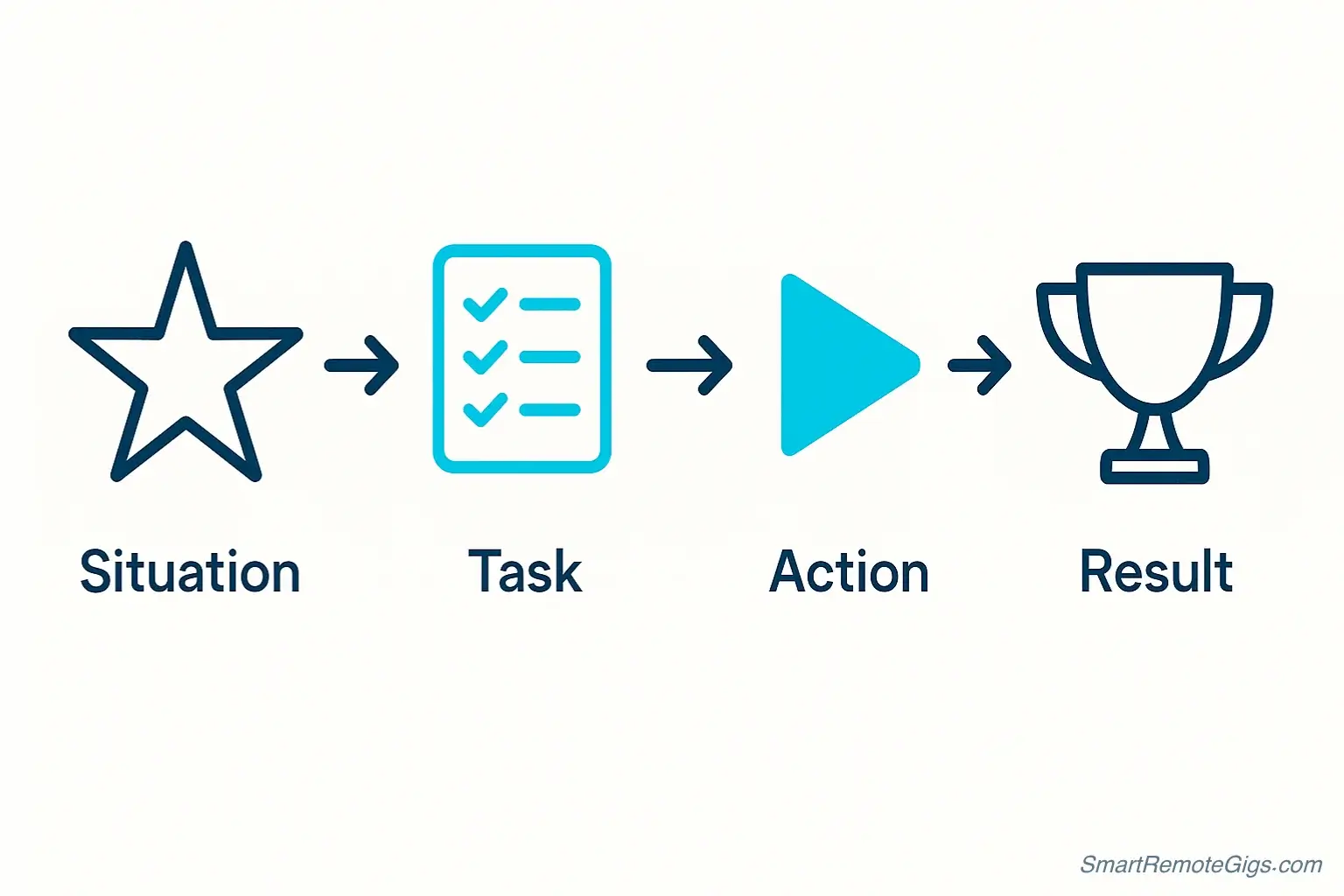
Prepare for behavioral interview questions using the STAR method (Situation, Task, Action, Result). Craft stories from your past experiences that demonstrate your problem-solving abilities, honesty, and how you prioritize tasks under pressure.
Find and Apply to the Best Entry-Level Tech Support Jobs
Be strategic in your job search. Target major BPO companies, direct corporate hiring programs (like Apple At-Home Advisor), and specialized tech job boards. Optimize your resume and application timing for the best results.
Follow the IT Career Ladder for Strategic Growth
View your Tier 1 role as a launchpad. In your first 6-18 months, focus on mastering the role and earning your CompTIA A+ certification. This sets you up for advancement to Tier 2 and future specializations like Network Administration or Cybersecurity.
Tools:
- A skills-based resume
- An optimized LinkedIn profile
- The STAR method for interviewing
- A study plan for CompTIA certifications
- Accounts on tech job boards (e.g., Dice, FlexJobs)


